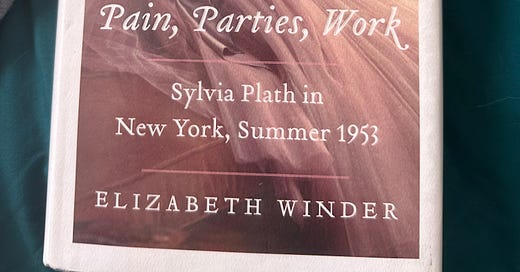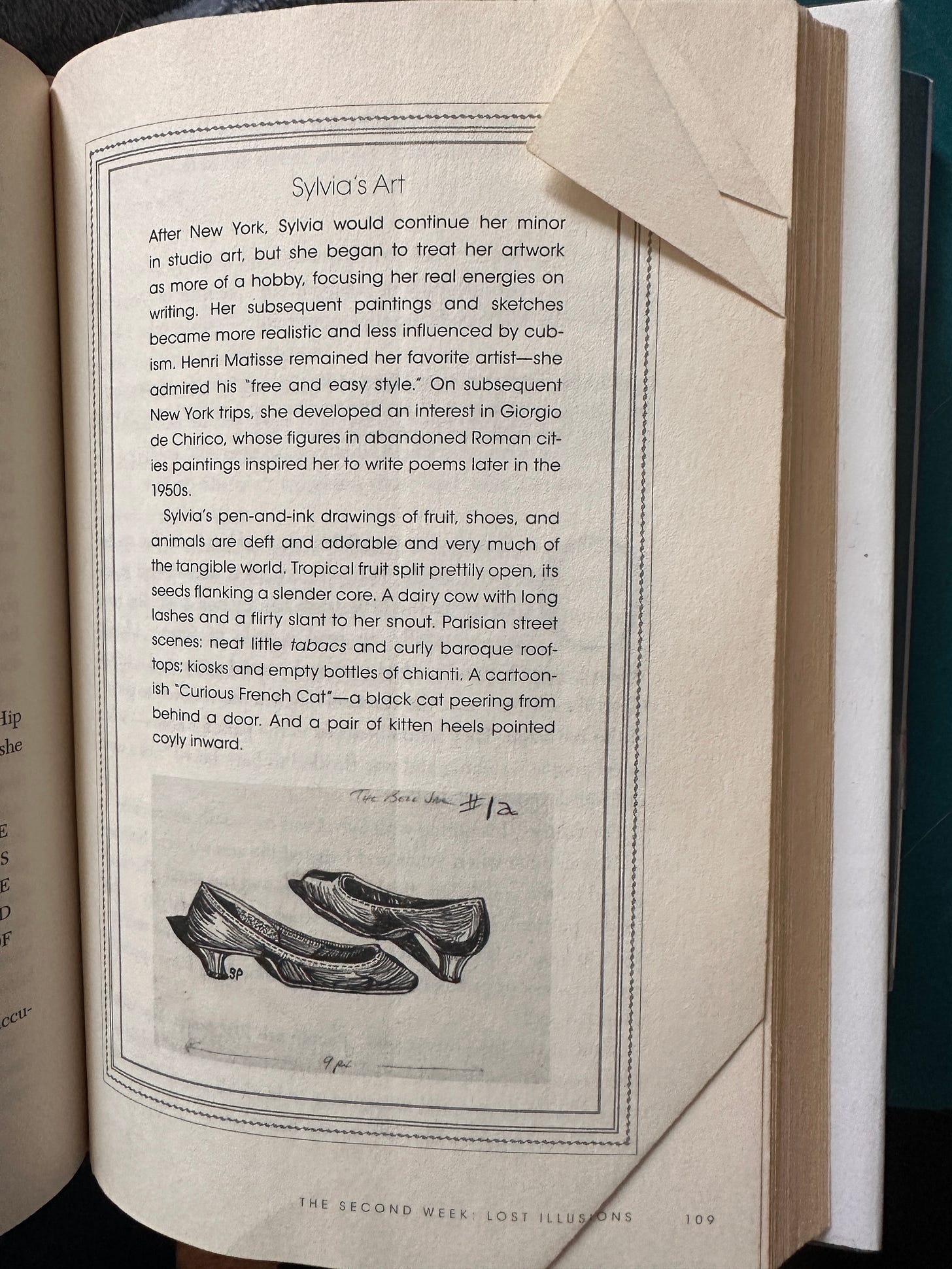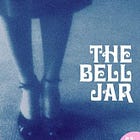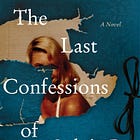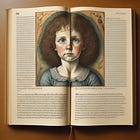Pain, Parties, Work … Sylvia Plath’s Bell Jar Summer
On fashion and beauty, art and writing, depression and handwriting analysis in a key summer of the author's life
I have continued on with my love affair with Sylvia Plath, most recently reading Elizabeth Winder’s book: “Pain, Parties, Work: Sylvia Plath in New York, Summer 1953.” If you’re familiar enough with Plath and The Bell Jar, then you’ll know that this year was the summer during which the book is based on. It’s actually not a whole summer but just a single month internship, when Plath was excited to be writing for a magazine in the city but was also falling into a deep depression that would lead to a suicide attempt upon returning home. I was surprised to learn that the prolific writer didn’t keep a diary during her trip, but she did write letters and these, combined with tales recounted from the other women at the internship with her, build the story that Winder shares with us.
Fiction, Truth, Fashion and Beauty in The Bell Jar
This non-fiction account shares an incredible amount in common with the novel, a novel that was more autobiographical than not, but the differences are also notable. The number one difference is that Winder celebrates Sylvia’s love of fashion and the way it played out that summer as she worked at a fashion magazine in a fashionable city. Although clothes are mentioned in The Bell Jar, the non-fiction account really sparkles with the joy of fashion. And this stands out to me not only because it is fun but also because fashion is a form of creative self-expression. Plath wasn’t writing in a diary that summer but she was expressing herself through her clothing, expressing who she was and who she wanted to be.
She enjoys shopping for the clothes that she sees herself wearing in New York. She enjoys dressing in them throughout the month. But as time goes on, and her depression creeps up, the joy she takes in them shifts. The scene in The Bell Jar where she throws all of her clothes out the window apparently did really happen. And then she realized that she needed something to wear the last day. She went to a friend’s room and asked to trade her bathrobe for an outfit, choosing a look as opposite to how she’d arrived as possible. Winder writes:
“Putting on a friend’s shirt or dress is a surprisingly powerful gesture. The shirt can be pilled and ratty, the dress can be too loose - but it releases you from your own itchy skin for a while, no matter how unflattering the color or cheap the garment.”
Was she just so uncomfortable with herself by this point that she needed to wear someone else’s life? In addition to fashion, there’s a lot about beauty in the book as well - which isn’t surprising for young women working at a fashion magazine, but there are some intriguing things that come out of it including this:
“She hated how New York turned her complexion to a sickly pallor. And for Sylvia, writing and tanning were linked: “I need to be tan, all-over brown, and then my skin clears and I am all right. I need to have written a novel, a book of poems, a LHJ (Ladies’ Home Journal) or NY (New Yorker) story, and I will be poreless and radiant. My wart will be non-malignant.”
I am so intrigued by this statement, by the idea contained within it that she needed to look and feel healthy or “all right” and then she would be able to write well. Perhaps I’m reading too much into this … perhaps she was just a girl who equally wanted nice skin and a writing career … but it seems to me that it suggests an element of magic related to wellness. Can one write when one isn’t well? Conversely, can one be well when not writing?
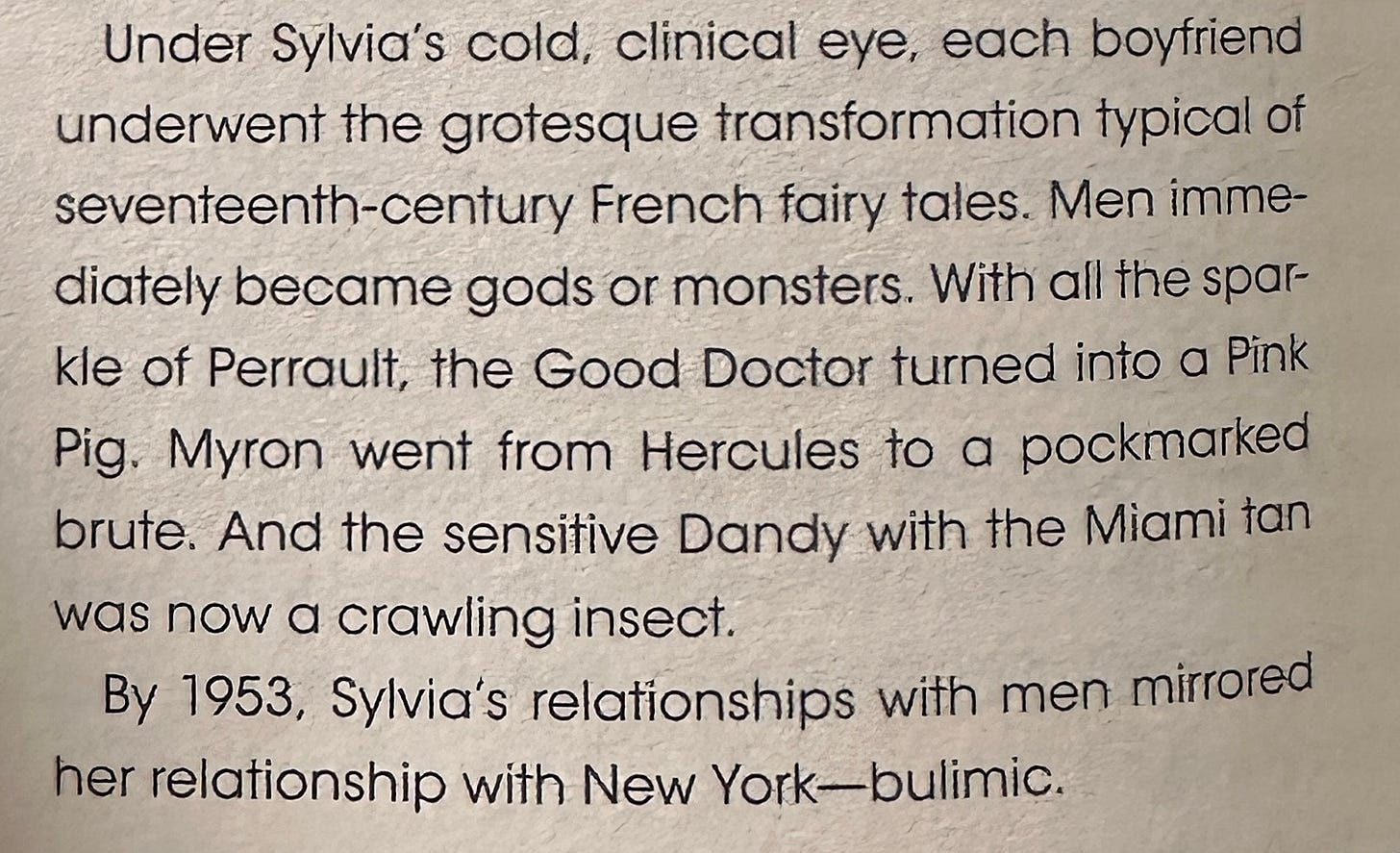
Handwriting Analysis
The book includes asides with lots of different information from that summer, and there’s one that I found extra fascinating: a memo explaining that a piece of writing she’d given to the magazine prior to arriving had been professionally analyzed by a handwriting expert named Herry O. Teltschler,) with one column for strengths and another for weaknesses based entirely on the handwriting.
According to the professional, Plath’s handwriting suggested:
“Strengths: Enjoyment of working experience intense: sense of form, beauty, and style, useful in fields of fashion and interior decoration. Eager for accomplishment. Weaknesses: Overcome superficiality, stilted behavior, rigidity of outlook.”
Winder writes that although Plath didn’t know that her handwriting would be used this way,
“Sylvia’s passion for self-analysis would have eclipsed any indignation she felt towards Mademoiselle’s methods.”
Sylvia’s interest in her own mental state and that of others was a growing, persistent interest. Later in the book we learn:
“In fact, before her arrival in New York, she had written to Mademoiselle that her academic interests were shifting away from English and towards psychology. Sylvia actually wanted to work in a psych ward - maybe as a receptionist. (And she would, years later, in Boston - an experience that would inform her best short fiction, “Johnny Panic and the Bible of Dreams.”)”
What Plath didn’t know when she received the memo was that the handwriting expert had actually:
“Written a letter to Betsy Talbot Blackwell, warning her that one of her guest editors was on the brink of a nervous breakdown.”
And it was confirmed that this was about Plath. I wonder if there was anything within the content of the words themselves that inspired the handwriting expert to say this or if it was all because of the shape and style of the physical handwriting?
I may find this fascinating regardless, but I find it particularly fascinated in the context of Plath at this time, because of the fact that a huge symptom of her depression was that her handwriting began to change and then she stopped being capable of writing, something I mentioned in other posts and which actually inspired me to research and write this article:
There’s another small line in the book where the author notes that Sylvia loved:
“Textile words like balzarine, boucle, and velveteen. Even her shapely handwriting - each letter perfectly formed and hanging coyly separate.”
I don’t know what to make of that description of her handwriting, but I noticed it, I marked it, I’m curious about it. I am curious to see what emerges as I continue exploring handwriting and Plath and the intersection of the two through the lens of how mental health impacts creativity. Contrary to what I’ve read elsewhere, Winder makes the comment that at least in Plath’s journals “her clearly rounded, deliberate handwriting remained the same throughout the duration of her life.” So I have more to explore in this area!
Signs of Depression
We see Sylvia’s symptoms of depression emerging throughout the book, even in the earliest days on the trip. If you’ve read The Bell Jar then you might recall that there’s a powerful scene where there’s a photo shoot and the photographer asks each girl wants she wants to be and the fictional Plath (Esther Greenwood) becomes immobilized by the question, is handed a rose to represent poetry, and bursts into tears. The real life scene this is based on actually took place on the first day of the internship. Plath is tired and overwhelmed and excited and all of the things and she does cry and eventually her photo is taken. She sits down afterwards and writes “a letter to her high school teacher and mentor Willbury Crockett, saying, “I have let you down.” Immediately, I think of the self-doubt in depression … and wonder if writing a letter to release the feelings about it was helpful at all?
About a week into the internship, Sylvia and Laurie go to the zoo together where they are “appalled by the conditions, the small cages, and the smell.” And:
“Out of the blue Sylvia said, “People are like boxes. You would like to open them up and see what’s inside but you can’t.”
The following day, Sylvia wrote a letter saying:
“Life happens so hard and fast I sometimes wonder who is me … life passes so fast and furiously that there is hardly any time to assimilate it.”
Winder notes:
“Even this early in the month Sylvia was already exhausted, and the remainder of the week was tightly scheduled with Mademoiselle activities.”
There’s a lingering question about whether her experience at the magazine caused / exacerbated a depressive period. Anne Hawber, also an intern that summer, shares in the book that Sylvia really wasn’t cut out for the technical details required of her particular editing position, that she would have been best suited to work as a fiction editor or could have enjoyed some of the fashion writing jobs. She says:
“I had felt all along that Sylvia was in the wrong job, and that Mlle had contributed to her breakdown. She should have been fiction editor. And what she experienced in her job must have been very hard on her, especially when her fantasy mind had distorted the whole picture so much beforehand.”
Anne also notes that any position would have been better for Sylvia if it “allowed her to dream and putter and waste time.” Lately I have seen so much writing, and have been thinking so much myself, about the importance of rest and downtime and daydreaming in the creative life. I have been exploring the idea that creating isn’t just the actual act of writing but the entire cycle of resting, absorbing, experiencing, discussing … If Sylvia had been able to do work that she enjoyed more and had lots of downtime that summer to take it all in, would she have had her breakdown? We’ll never know. And from my personal experience of depression, I would say she probably would have. But the overwhelm and discontent and pressure of a job that was technically hard for her combined with the lack of time for rest certainly could not have helped. Ironically, it might have felt like it was even helping at the time … I, myself, have tried to outrun my depression with a flurry of activity and it can be a good distraction for a little while but eventually it catches up.
By mid-month, Sylvia writes:
“I am worn out now with the strenuous days at the office and the heat and the evenings out. I want to come home and sleep and play tennis and get tan again - I am an unhealthy shade of yellow now.”
Or as Winder describes it:
“Midway through her month at Mademoiselle, she was hungry, dehydrated, and drained of all her initial glittery energy.”
She needs to rest and life is not letting her rest and most of us have experienced that and some people manage to push through somehow and some people collapse or run out of spoons so to speak.
On Art and Writing
There’s a terrifically unique chapter in the book called a Dictionary of Adolescence, which is, as the same suggests, a dictionary-style listing of various things related to Plath’s life. It’s something I want to try myself as a writing exercise. Entries include:
“ART. She drew in pastels and colored pencils and crafted handmade cards for her family.”
I am intrigued by the art part because I have always found that with writing as both my creative passion and my living, I have to also have other non-monetized creative outlets and making cards for people is one of my things. I have also found that in depression words sometimes don’t come to me but I can put together images instead. I wonder if Sylvia would make cards when she couldn’t write words?
Later in the book we learn:
“Sylvia had a lifelong talent for design and was minoring in art at Smith. She did many self-portraits - in pencil, charcoal, or pastels - but most compelling are the collages. She bound them in thick scrapbooks the color of moss, on matte pages pasted with gold and cream paper shapes like Matisse’s cutouts.”
There is no more about this in the book, but it’s something that’s now on my list of things to learn more about if I can. I am curious about the collages because I collage but I am especially curious about the self-portraits because of the complexities involved in how we see ourselves and present ourselves to the world as artists with mental health challenges that may sometimes distort or perception of ourselves.
“ARTISTIC IDENTITY. Sylvia’s identity as an artist was classical, with a sort of hammered-gold elegance. She was more Voltaire than Rousseau - her artisan-like approach to writing - and her idea of masters in general - came straight from the Old World. She had no romantic notions of “inspiration” and beat her passions into beauty with hard work.”
I find this one intriguing in the context of a writer with depression because I have learned again and again that although I need to be gentle with myself when symptoms make it so that I can’t write, I also can’t sit around hoping for inspiration because inspiration often can’t penetrate through depression, so I just have to put in the work until the fog lifts. I wonder if this was true for Sylvia as well … or if myriad other reasons led her to this approach to a writing career.
Although Plath apparently only wrote one diary entry during her summer internship, she was an avid journal writer beginning at age 9. Winder writes something interesting:
“The journals show a remarkably solution-oriented person. Even in the midst of the blackest depression, her thoughts had a beautiful practicality to them, rapid fire, and directed outward. Sylvia was not content to roam the wild moors of her mind for its own sake - she was totally in love with the external, physical world and wanted to stay there.”
Plath’s journals are on my To Be Read stack, so I’ll sure circle back to this, but for now what I wonder is if writing about the concrete, physical world was an act of grounding that helped Plath when being in the ruminations of her own mind was too much. Just like in The Bell Jar, Sylvia returns home after the internship with the intention of reading and writing for the rest of the summer. But she is rejected from a summer fiction writing class, and she is trying in vain to plod through reading Joyce, a feat which makes her feel like she’s become illiterate. She is trying to figure out her own identity, and if she is a writer who can’t read or write, then what is she?

Symbolism of the Seagull
This is really a tiny part of the book but I noticed it and kept thinking about it. Before they’ve even left for New York, Sylvia meets Laurie Totten, one of the other women going on the trip. They talk about a variety of things. Laurie recalls how impressed she was that Plath had won Seventeen magazine’s fiction contest, which she herself had entered but not won. I smiled at this because I also sent writing to Seventeen when I was a teen (albeit in the early 90s not the early 50s) and it also was not accepted. During this conversation, they asked one another what they would like to come back as in another lifetime. Laurie says, “I wanted to come back as a wolf, explaining that the wolf was much misunderstood and not nearly as big and bad as most people thought. Sylvia’s choice was a seagull.”
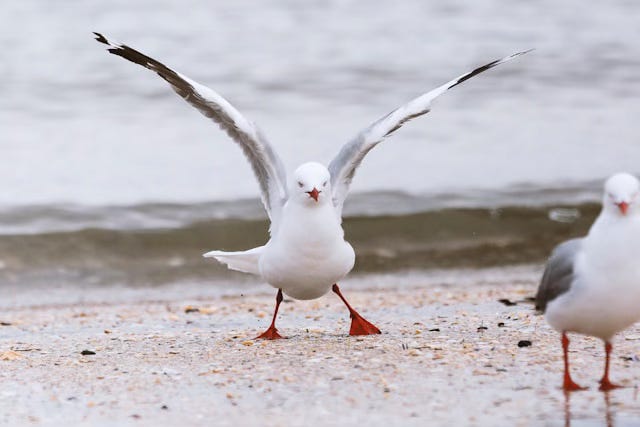
There is no more said about this, so we don’t learn why she chose the seagull. I couldn’t resist doing some Googling about what seagulls can symbolize. Unsurprisingly, they represent a vast variety of things in different cultures and mythologies across time, but I want to share this from World Birds:
“Seagulls may also represent navigation. In this sense, gulls can be connected with finding the right path, or finding one’s own way home, no matter what the conditions are like.”
I like the idea that somewhere deep inside Sylvia intuitively knew that she would keep finding her path despite the hard experience.
Art and Mental Health Takeaways:
In summary from the above article:
Fashion can be a form of creative self-expression. Noticing how your clothing choices change may be a helpful clue to your own moods. Conversely, trying on clothes that you’re “not in the mood for” could potentially shift your emotional state.
Writers often need other outlets for creativity, too, which may include fashion and beauty, painting and drawing, creating collages, etc.
There is some kind of relationship between wellness and creativity. Some people may feel that they are at their most well when they are creatively fulfilled. Some people may find that when not well, creativity doesn’t flow … it practically gets stuck in the pores.
Handwriting may provide clues about a person’s mental state.
Even avid journal keepers don’t always write in their journals even during pivotal times in their lives. It’s okay if you fall off writing; you can always come back again.
Writers with mental health challenges often take a strong interest in the field of psychology.
People often need space and rest and time to putter as a means of taking care of their mental health, with symptoms exacerbated by overwork and overwhelm. Workplaces may not be aware, or care, about this but have the potential to help or harm.
This book is about a time when Plath is young, and I can’t help but relate it to my own experience of late teens/ early twenties depression. I wasn’t diagnosed with depression until my late twenties, but looking back I can see that that’s what this time was for me. But what I can also see is that depression is a very simple word for what’s a really complicated in a young woman’s life. Depression isn’t just a state of mind within the individual; it’s not a noun but rather a verb; it isn’t static but rather dynamic, interacting with hormones and life stressors and identity and society …
The way I read it, based on my own experience, Plath was likely experiencing some form of depression as she headed off to New York. Perhaps she even applied to that internship in part with the hope that it would fulfill her and excite her and stave off the depression. I know that at the same age I took a photography job for that reason, I traveled around the country for that reason … I didn’t recognize “I am in depression and trying not to be.” Instead, I felt a whole lot of feelings and had even more thoughts. They were colored by depression but they were also the very common struggles of coming into my womanhood, feeling the pressure to figure things out particularly in regards to wanting a creative career, trying on fashion that represented who I wanted to be and never quite feeling like I fit in or even really like I knew who I was.
I’ve written about my view that we all exist on spectrums of mental health and creativity. During that stage of my own life, my mental health was not at all good. But my drive to create was vibrant and strong and I think helped offset the mental health stuff for a time. The depression showed up plenty, as it did for Plath crying at her photo shoot, but I was also able to do many interesting things, as Plath did exploring New York that summer. At some point, my scales tipped and I slid further down on a mental health decline that eroded the creativity part even though it still existed there. I read Plath’s summer of 1953 through this lens.
Art and Journal Prompts:
I offer you some creativity prompts that you can use for journaling, creative writing, as a start to an art project, or however you may see fit.
If you could come back as any animal, what would you choose and why? You may want to draw this animal, create a puppet of it, and/or research the symbolism of it.
What do fashion and beauty mean to you as they relate to creative self-expression? How does your style reflect your creative self and how does it reflect your mental health?
What is the relationship between wellness and creativity for you? Consider: “Can one write when one isn’t well? Conversely, can one be well when not writing?”
What time in your life does Plath’s New York summer most remind you of? Write a letter to someone from the point of view of being back in that time. Or make a collage that represents that time period.
Re-read the description of Plath’s Artistic Identity in the essay and then write out your own in the third person.
Plath loved “textile words like balzarine, boucle, and velveteen.” Make a list of words that you love, drawn from a craft or industry that inspires you. Use these to write a story or poem.
Use magazines to create a collage that represents your self-portrait.

Related Tips for Using Creativity to Improve Wellness:
In addition to the above prompts, you might want to try some of these creative activities to help improve mental health:
Choose to wear an outfit that you would never normally wear. Perhaps you might borrow one from a friend that you admire. Explore how this change makes you feel mentally, emotionally, physically and creatively.
Write a letter to your younger self sharing the things you know now that you wish you knew then.
“People are like boxes. You would like to open them up and see what’s inside but you can’t.” Create a box that represents what people would see inside if they opened you up. Explore what parts you tend to leave in the box and how you might authentically share them.
Explore a new craft/art/hobby that is entirely separate from the one that you make a living off of or are trying to “take seriously.” It’s important to spend time being creative that is just play with no other agenda.
Choose three words that summarize where you’re at in life right now. (Winder described this time for Plath as “pain, parties, work.” Explore each of those three parts in depth, including how they serve you and what you might wish was different about them.
Related Tips for Coping with Mental Health Symptoms That Impact Creativity:
Do you have symptoms that are impacting your ability to create? Here are some additional wellness tips:
Try working with a professional in handwriting analysis. Or take a personality test. Or read your horoscope. Or find another way to explore different aspects of yourself. Remember that they may not be accurate or complete but if you pay attention to what resonates and what doesn’t in these things, they can sometimes provide important clues and information about yourself.
Brainstorm a list of what you perceive as your own strengths and weaknesses. Go through each way and list at least one reason that it actually helps your creative self. Yes, the weaknesses also help you.
Rest. Simply rest. Give yourself permission to truly and fully rest.
Affirmations, Quotes, Meditations, Etc.:
Reading or writing affirmations / mantras can be very powerful. In relation to this article, play around with writing them down (I usually do ten times each for the one I’m working with) and then with simply thinking them or reciting them out loud and see what feels best for you.
Dressing up empowers my inner self.
Wellness fuels my creative flow.
Embrace rest, absorb, and create.
Self-analysis guides my growth.
Embrace downtime and daydreaming.
Artistry is a product of hard work.
Writing grounds me in the physical world.
I will find my path, no matter the conditions
Writing is my outlet for self-expression.
I honor my mental health as essential for creativity.
Rest and rejuvenation fuel my creative spirit.
Embracing the external world grounds my mind.
I find strength in the face of challenges.
I am resilient, and I can overcome obstacles.
Each day brings new opportunities for growth.
I trust in the journey of finding my true self.
Or choose three luscious words that inspire good feelings for you and repeat them as a mantra. Like Sylvia’s: balzarine, boucle, and velveteen.
If you read this far, perhaps you liked the work. The work does take work. It only continues with support, so please consider subscribing. My annual rate starts at $10 per year.
Additional Resources:
The Power of Fashion: The Benefits of Creatively Expressing Our Self-Identity Through Our Physical Appearance
Johnny Panic and the Bible of Dreams by Sylvia Plath
Sylvia Plath in New York: 'pain, parties and work' - The Guardian
Pain, Parties, Work: Sylvia Plath in New York, Summer 1953 - The Marginalian

